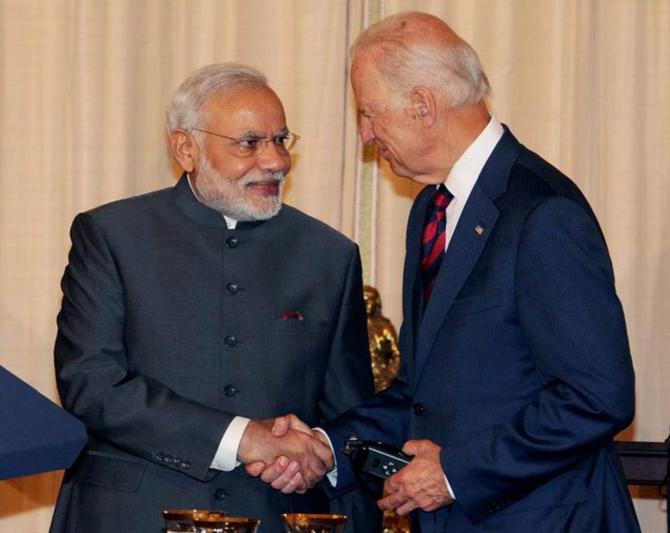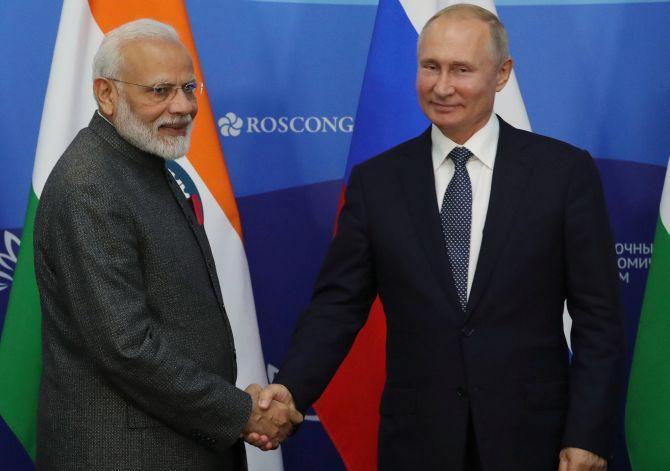US-India defence cooperation must not adversely affect the India-Russia interface, which has its own strategic meaning and content, asserts Vice Admiral Premvir Das (retd).

In the recently concluded dialogue between the defence and foreign ministers of the US and India, the last of the four 'foundational' agreements, titled the Basic Exchange and Cooperation Agreement, BECA, has been signed.
It promises India access to real-time geospatial information apart from other things and presupposes access to the most advanced technologies that are currently available only to America's NATO allies.
India's strategic relationship is now at an altogether higher level which, apart from other things, will ostensibly help in our interfaces with China.
The Indo-Pacific has been mentioned repeatedly stressing our common interest in ensuring safety of navigation and freedom of movement in this water space.
In short, the meeting signals, without actually saying so, that the two countries are allies. It is necessary to give some context to this relationship.
Defence cooperation is nothing new to India. Until the mid-1960s, this focused entirely on our relationship with the British.
Almost every item of military hardware and even the doctrines followed by the armed forces originated in the UK.
Multilateral engagement at sea termed Joint Exercises at Trincomalee, was carried out annually between the navies of six Commonwealth countries including those of India and Pakistan that had fought among themselves in 1948. This began to change after the War of 1965.
The British were distinctly cool to our requirements, especially of modern submarines. Efforts to get these from the US also proved abortive as that country asked us to route our needs to Britain.
It was then that defence minister Y B Chavan headed to the then USSR and within a few years India's needs, and more, began to arrive and that too on very favourable credit terms, with the cost having to be repaid over 15 years at 2 per cent interest.

Thus, by 1971, when the next war with Pakistan came, India could field missile boats and F-class submarines.
What the former did to enemy units and installations at Karachi is now too well known to bear repetition.
Over the years, more platforms of better quality kept arriving for all three services and, by 1990, India's military was a vastly superior entity than it was in 1970.
The icing on the cake came with the lease of a nuclear submarine in 1988. In this same period, technological know-how to build platforms, including ships and aircraft and the weapons, sensors and machinery fitted in them was transferred.
This led to manufacture, in India, of platforms like BMPs, T72 followed by T90 armoured vehicles, MIG-21 aircraft and later SU 30MKI, missile vessels and once again, to top them all, nuclear submarines of the Arihant class and their reactors.
The Brahmos missile system came next.
Not to be forgotten is the India-USSR treaty of 1971, which effectively deterred the Chinese from intervening in that conflict.
The relationship is still ongoing -- witness the lease of another nuclear submarine and the S-400 missile systems, albeit somewhat diminished.
This brings me to the India-US defence relationship. Following the distinctly hostile position taken by that country in 1971, military interface, already marginal, was further eroded and remained so until 1990 when the USSR collapsed.
In this dramatically changed scenario, then prime minister P V Narasimha Rao saw the need for India to make a course correction and so did the US.
In January 1995, then US secretary for defence William Perry visited India and a two-page Memorandum of Cooperation was signed.
However, American sanctions following India's nuclear weaponisation in 1998 inhibited the relationship from gaining traction until 2005.
The cooperation took wings from the renewed agreement concluded in that year. Since then, it has resulted in supply of sophisticated military hardware, mainly aircraft, valued at nearly $20 billion, which has made the US our largest supplier of military hardware ahead of the erstwhile USSR, now Russia.
Interestingly, though, there has been hardly any 'Make in India' element in these purchases, leave aside manufacture of F-77 howitzers.
India's submarine production line was initially German assisted and is now continuing through French collaboration.
In sum, the India-US defence cooperation is largely platform purchase related. The one major non-acquisition activity is that of joint exercises between the militaries of the two countries and notably their navies, named Malabar.
These, however, have moved from being bilateral to quadrilateral and are largely professional; to read strategic content in them may be somewhat over-stated.
Any future possibility of manufacturing American military platforms rests on our procuring their F-18 fighter aircraft.
When asked by an American reporter if this would happen, Defence Minister Rajnath Singh was ambiguous, stating only that such purchases were based on negotiations with many parties.
So indigenous manufacture of major military equipment of US origin is still not on the horizon.

Clearly, close engagement with the US is to India's advantage, given the existing geopolitical scenario and the noticeably assertive posturing by China.
But it should not be confused with the developing quadrilateral with the US, Japan and Australia, which are military allies.
While engaging the US, we have also to recognise the leverages that we can have with China through Russia, if not now then at some later date, and the impact that a diminishing relationship with Russia can have on our military preparedness; that country also has substantial energy resources.
US-India defence cooperation must not adversely affect the India-Russia interface, which has its own strategic meaning and content.
Despite all the rhetoric, the US will not get involved in any military confrontation that we may have with China; nor will the Russians for that matter, but the latter can make life difficult for us by supplying Pakistan with sophisticated weaponry, which they have refrained from doing so far, largely at our behest.
To keep both relationships going together, however, is easier said than done, given the tense interface between those two countries today that could actually worsen in the new US dispensation.
These are, therefore, difficult times for India's decision makers. Maybe, it is advisable to make haste slowly.
Vice Admiral Premvir Das (retd) has served as a member of the National Security Advisory Board.
Feature Presentation: Rajesh Alva/Rediff.com











